When we think about world-famous electronics markets in Asia, usually Shenzhen, Tokyo’s Akihabara, or Shanghai’s Beijing Road come to mind.
There’s another market that I’ve had my eye on for a few years: Nhật Tảo market in Ho Chi Minh City, Vietnam. It might not be as large or accessible as the more well-known markets, but it’s very much worth a visit if you’re in the area. I decided it was time to hop on my red motorbike (red things go faster) and give you a short tour of the central market, as well as some more hobbyist-friendly options.
Overview
Nhật Tảo is a busy market. A good strategy is to go in the late morning or early afternoon on a weekday or Saturday. It’s slightly less busy at those times, and I avoid Sundays because some stores will be closed or have reduced hours. Do not go during rush hour.
If possible, go with someone who speaks Vietnamese. Someone from Fablab Saigon might be willing to help you out if they’re available (more on that later). You may even run into the author of this article.
Electronics suppliers in Nhật Tảo are set up for the local market. While we will cover a few exceptions, most only speak Vietnamese, and high-volume retailers aren’t really set up to answer detailed questions in any case. In these places it’s best to know what you’re looking for, but luckily all the stock tends to be visible, and the vendors all have calculators they can use to quickly show you prices. All business is done in local currency and in cash.
Our focus will be on locations that have been present for at least the last two years and are likely to still be there for a while, as the overall stores and stock tends to be pretty fluid.
One major convenience worth noting is that haggling over price is rarely necessary: my experience has been that these stores sell their products at set prices that do not depend on your nationality. While I’m by no means fluent in Vietnamese, I do speak enough to confirm this, and I know several of the vendors personally.
A word of warning – Google translate does not handle Vietnamese gracefully yet. It works reasonably well for single words or very short phrases, but anything longer often becomes unintelligible. For example, it sometimes translates ‘ten’ as ‘salt’ by getting the tonal accents wrong. Speaking of condiments, Nhật Tảo market borders on District 5, which is considered by locals to have above-average restaurants. You may want to scope out a place to eat after going to the market.
A Tour of Nhật Tảo Market
We start our journey at the corner of Lý Thường Kiệt street and Nhật Tảo street in District 10. This is near address 138 on Lý Thường Kiệt which is a major thoroughfare. It’s better to use this address than ask for Nhật Tảo market, as there is a fresh produce market elsewhere by the same name. The safest way to get there is by taxi (use VinaSun or Mai Linh brands only), although there’s an application used locally called GrabBike that will call an inexpensive motorbike driver at fixed rates, and they always have a helmet for you.
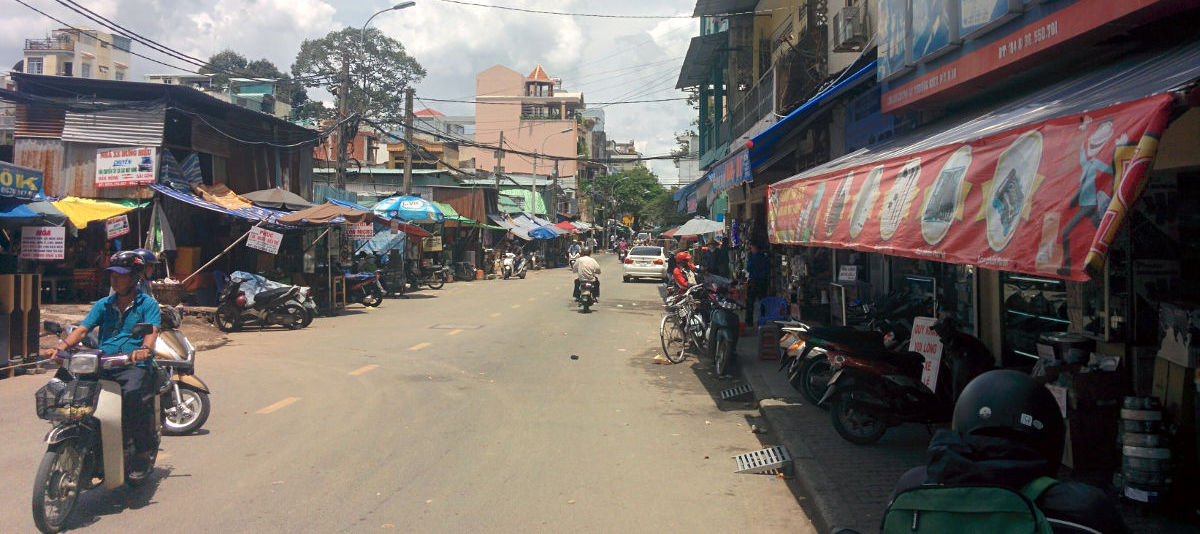
Immediately to your right is one of the better stores to buy tools. They have a decent selection of soldering and hot air rework stations, you can get an ‘all-in-one’ that includes a variable voltage power supply and an RF detector (for cellphone repair) for around 60 USD. My “Pro’sKit” one has lasted four years of moderate use without complaint. The hand tools are pretty good here too, and it’s not usually busy, so if you have some questions they will patiently accommodate you. They even have a website, although in Vietnamese only.

Continuing down Nhật Tảo street, you will see a couple of places selling various LED strips, audio amplifiers, and speakers. Take your first right down the alley, passing more similar retailers until you encounter a main road. Cross the road, passing under a gate, to enter the LED street:
To the right as you walk down the street there are many retailers selling every conceivable type of LED strip and sign. This is one of the places local advertising companies (the stores with signs labeled ‘Quảng Cáo’) buy the raw materials to meet the massive demand for LED signs in Ho Chi Minh City. If you dig around, you can find painfully bright Arduino-compatible LED matrices for around USD 9. Be sure to pick up a power supply module at the same time; they’re worth the price as the sign modules consume more power than common wall adapters can easily manage.
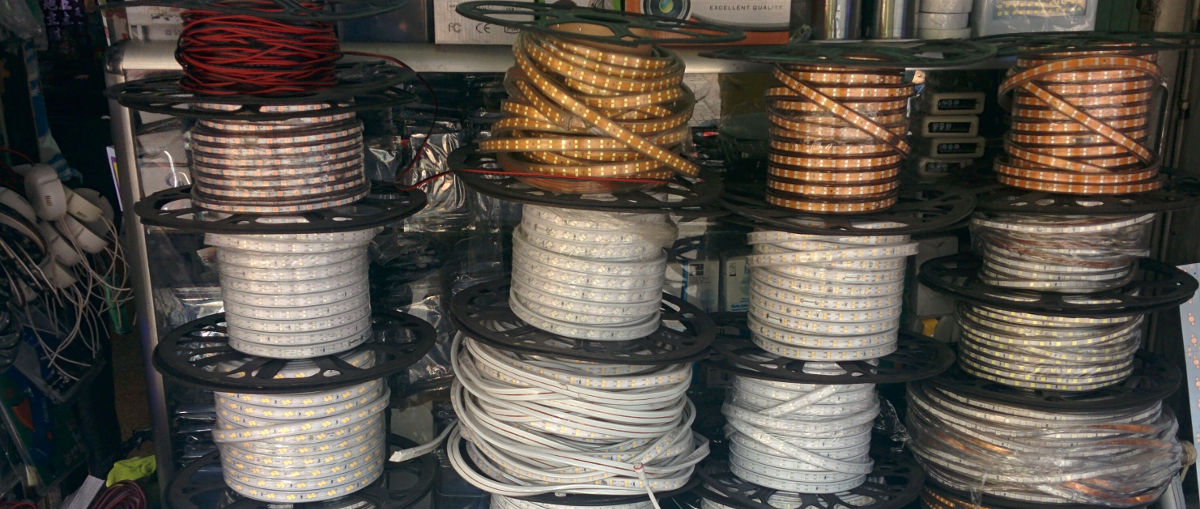
This street also has a few shops that carry more or less only multimeters, wall to wall. The focus is mainly on inexpensive units, but they’re quite decent overall.
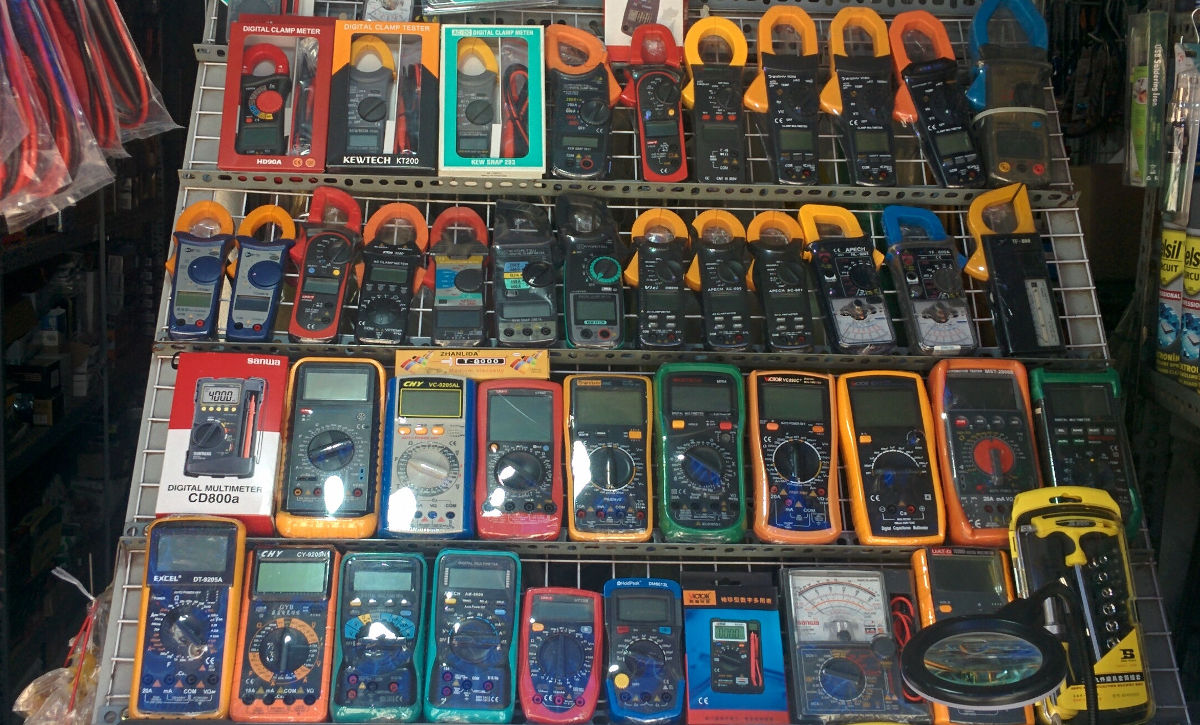
Along the left side of the street, you will see what looks like large apartment blocks with the entrances labeled ‘Nhật Tảo’.

The first two floors of these blocks represent the core of Nhật Tảo market and are a labyrinth of stalls crammed full of components. It can be disorienting, but very generally the first floor is the most interesting, selling a variety of components, connectors, and tools.
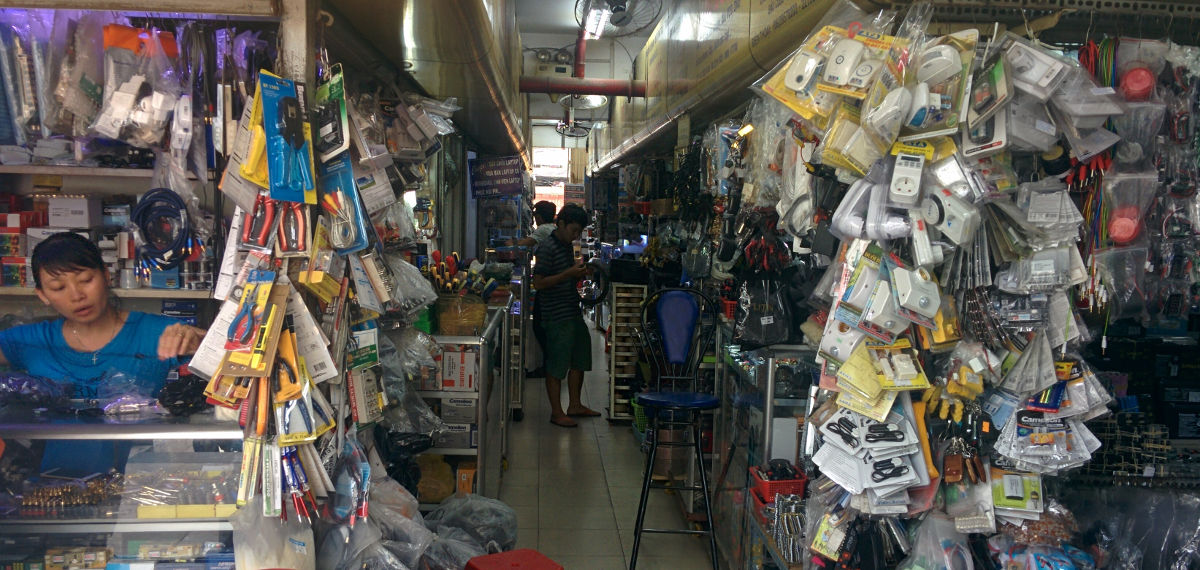
Typically, stores will focus on selling a few items, such as transistors and resistors. Don’t mind the mess: if you request a particular transistor part number it will appear in front of you with alarming speed.


Of particular note are the project boxes available. You can get medium-sized ones for about USD 0.55, and the quality is quite good.

On the second floor, the focus is mainly on laptop parts and repair. Most of the stock is a bit older, and unless you live in Vietnam and need to buy parts to repair your laptop or desktop computer, there’s not much you will need here.

Beyond Nhật Tảo Market
If the central electronics market proves too hectic, or language barriers win the day, there’s another option close by. A local shop called Hshop has an excellent selection of hobby electronics, their staff speak English, and they have a decent website (Vietnamese, but supports English search terms). They also offer a laser cutting service, and when you buy something they will test it in front of you if possible to ensure you don’t get defective parts. The price is a little higher than the main market, but this is hands-down the most hobbyist-friendly electronics shop in the city and they carry some really cool stuff, especially sensors.
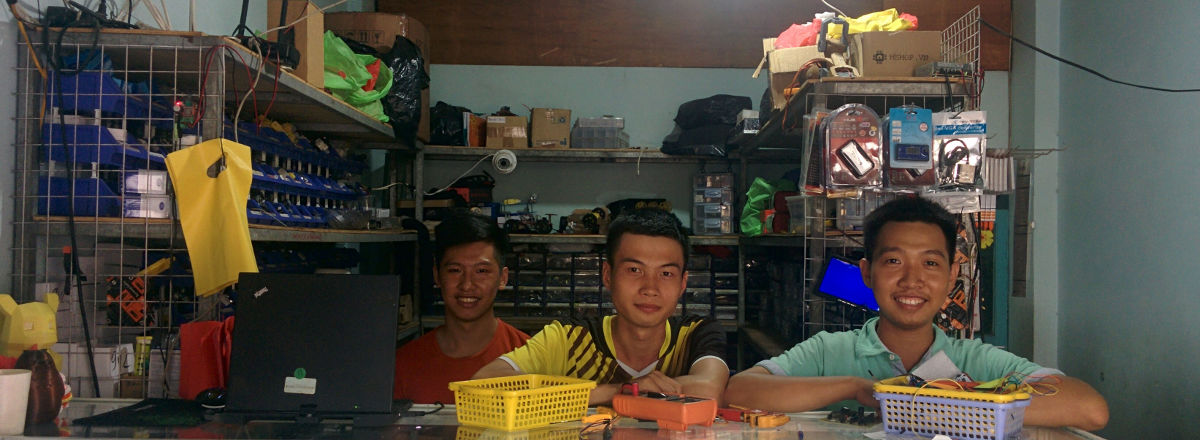
Finally, I know of one well-stocked market in the suburbs, not far from a local Fablab, that mainly supplies students at a nearby university. While most days there are no English-speaking staff, you can select what you want on their website and show up with a list, so it’s a smoother experience than the central market, and the prices are excellent. They also carry some sewing supplies in addition to electronics, and their selection of industrial buttons is very nice.
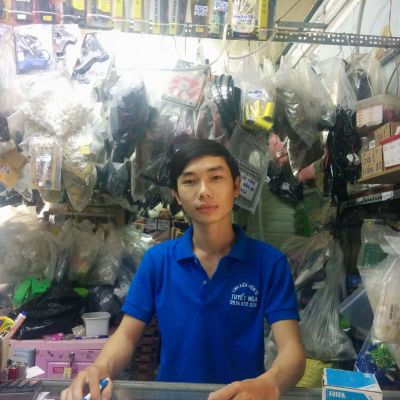
They’re hard to find, though. Your best bet is to go to the local market (chợ Gò Vấp). Starting from this point on the map, go southeast down Nguyễn Văn Nghị street until you see a big red fast food chain called ‘Lotteria’. Turn right there, continue for about 80 meters, then turn right onto Nguyễn Văn Bảo. Near address 31, you will see a tiny alley to your left (it’s right before a school). Go down that alley to the end, and turn right. You’ll suddenly be inside a store.
Don’t underestimate it – they seem to have somehow made it bigger on the inside than it is on the outside. This place is perfect if you’re planning to visit Fablab Saigon while in town, or if you’ve got a flight soon and need to stay closer to the airport.
Fablab Saigon
Besides being a place full of smart people building awesome things, Fablab Saigon carries its own stock of parts that is sells. The store manager, Hải, also runs a parts sourcing service. He can help you buy just about any component you need in Ho Chi Minh City, and he speaks English. The Fablab itself enjoys a large building with four floors. They offer laser cutting, 3D printing, a prototyping service, and they have a full coffee shop. The best thing about it though, is that despite offering these services, it remains a ‘place to meet great people’ rather than just a ‘place that sells stuff’.

In summary, Ho Chi Minh City has some excellent places to source electronic components and tools. It’s not really what you would call an ‘engineering tourism destination’ like Shenzhen, but it does have a rough, undiscovered gem of a market. If you’re visiting Ho Chi Minh City and are at all interested in hobby electronics, it’s worth a stop. You’ll find something cool, and anything you build with it will have a story.


















Looks like a nice market to explore.
Too bad most markets are getting replace by online variants like ebay and taobao. Comparing e.g. the HQB the first time I was there in 2012 and the last time I was there a year ago, lots of shops are vanished and not much of new stuff like esp or even Arduino is on display. Most people move their component sourceing to next day ordering through taobao.
Who needs a physical storefront when a virtual one (especially backed by a big name) offers more without all the downsides? People who don’t like crowds especially benefit.
There’s an emotional element to being there that you don’t get from online stores. Walking into a candy store is just more fun than shopping for candy online.
Tonight’s episode of Young Sheldon on CBS had the mother bribing the kid to do something… “This weekend… I’ll take you to Radio Shack!”
My mother used to bribe me the same way.
How would you ever find a Mogwai without visiting these hole in the walls??? I am kidding of course and I get where you are coming from Ostracus. I often receive sub-par or downright rude service from mouth breathers in brick n mortar stores which keeps me ordering things online but I feel like these are more inline with a flea market experience where the person selling has some sort of dog in the race like feeding their family vs showing up for a paycheck.
I really enjoy these articles and the pictures.
I love to have a shop like this around the corner or even within an half hour drive. The few electronic shops found here in the Netherlands only carry throughhole resistors or even 1206 at best. Most ICs are PTH too.
Also walking round a shop give me new ideas for future projects.
I’m with you SJAAK for I, too, shop for ideas by wandering around stores looking like a shoplifter.
fake and inferior components aka junk, but it’s cheap :)
Yeah, I was gonna say – why bother? If you’re a manufacturer, you wouldn’t cruise markets to buy components for your product – a recall (or bad publicity) is far more expensive than buying reputable components in the first place. If you are a one-off buyer looking for a few LED strips, you’d be better off saving the taxi fare (and perhaps air fare) and just buying local.
If you’re there, and bored, and don’t have concerns about excess baggage on the way home, it’s a great way to spend the arvo!
Fake parts can be frustrating. I do some prototyping here and it means extra testing for all those ‘what if 10% of these parts have half the specified current rating’ moments. I try to stick to low power designs, and if I can’t, I just over-engineer it well past specifications then test it under load. It’s not ideal, and I wouldn’t compromise where life or safety is at stake, but for all those other times… we need to make do with what we have.
That being said, if I was really worried about something being up to spec, I’d just ask the vendor. Some things are and some things aren’t. The good vendors know.
Knowing your supplier and they, in turn knowing you, is how you avoid fakes. Beating a vendor price down might make you feel good, but the vendor sells to meet your price.
I buy LEDs buy weight (in sacks)(here in SaiGon) and if I pay the higher price I know they will all work.
actually a lot of manufacturers/assemblers in Shenzhen cruise the markets for sourcing their parts.
Fake part can be an issue, but when having a god relationship between the seller and buyer this is less an issue as the seller wants to keep the buyer happy.
“but when having a god relationship between the seller and buyer” …
So, which one is the “god”, the buyer, or the seller?
B^)
Well shopping can be a matter of faith. :-) But seriously Vietnam has come far since the war.
I mend good relationship..
I’ve never experienced a marketplace like this. I may need to add it to the bucket list. Don’t tell the wife that that is why I want to go there though or I’ll be going alone.
I’m sure she won’t let you do alone. Wink, wink.
I went through a food market in Guangzhou years ago, it was interesting seeing the tubs of live scorpions for sale.
A few shops sold electronics, I was interested in Ni-MH batteries. The few I bought didn’t last as well as ones bought here in “The States”.
I bought some cheap saffron as well, only to find out it wasn’t for cooking, but dying cloth.
add kowloon shopping district in hong kong trip
bangkok has a center like that too
Can the tools run on 120 VAC 60Hz?
It depends. The power requirements of each tool is listed on it with a sticker or imprint just like you might be familiar with.
All tools here work at 220V/50Hz, but many are listed as 120-220V/50-60Hz.
Certainly any battery-powered device is fine or can be made to be fine.
In south africa getting the right components can be a frustrating time.
shops are either badly stocked or miles away.
And all the electronics are free, right? Because this is a communist country, right?
I don’t think you know what communism means. Or much else probably. Sad…
The ultimate goal of communism is, among other things, to eliminate money. See the Wikipedia article on communism or google /communism money/.
Of course, no country that has attempted communism has achieved that. It’s not even possible unless you either qualitatively change human nature, or cripple trade so severely that you limit everyone to subsistence living.
And so we see “communist” countries merely operating capitalist (but not free market) economies under heavily authoritarian control.
If you still think I don’t know much, I’d love to have you enlighten me.
Their “communism” is like European “free market”.
You’ve got to go see the world, man.
It’ll be a strange and different place to what you think it will be.
Even with strong government controls on market forces and capital ownership (ie communism) there is still money. There are still markets. People still expect money for their goods and services. This is a common delusion that is taught in American schools, that communists don’t use money and everything is “free”, except that they don’t have anything to buy.
I’ve been to 82 countries, and at least 15 of those are “communist”. They all have markets, and many of them have lots of electronics for sale (China of course, but Vietnam, Cambodia also have a lot, Cuba some, Venezuela not so much).
Notacommie, that’s my point exactly. BTW, there is no delusion taught in American schools: everyone knew that the USSR had a currency and it was the ruble. Everyone knows that China has the renminbi aka yuan and that Cuba has the peso. It is the stated *goal* of communism to eliminate money but as I said, no communist country has done so.
My original comment was meant to be a wry observation that even communist countries embrace capitalist concepts, and they are well displayed in these electronics markets.
And if you want to dig deeper, I was also making a point that communist theory is unworkable in its pure form.
Nothing is taught about communism in American schools except it is he name for some governments. Your notion is from the very distant past. The picture in the history or world cultures text is more likely to have happy peasants (former accountants and engineers) shoveling mud in a rice field during the Cultural Revolution – and not mention they died of common diseases, or went to prison for improper thoughts.
Yes “pay forward” on a nationalistic scale would require rewiring humanity.
Some of the purest attempts at communism were tried long before anyone called it that. Plymouth Colony, Jamestown and other early European settlements in North America tried it and in each case lots of them died of starvation because most of them wouldn’t put in the effort. They saw no return for doing more than the absolute minimum.
It wasn’t the natives who saved the pilgrims at Plymouth, it was tossing their failed communal ideals and replacing their way of operating with a capitalistic system where they could do what they wanted with their plots of land and freely trade their produce and labor with one another. Then they had plenty of food. The natives contribution was showing them which local plants and animals were good to eat.
How can we know this, hundreds of years later? Because the colonists wrote this stuff down in journals in explicit detail.
” They saw no return for doing more than the absolute minimum.”
Sort of like when Bernie Sanders was evicted from a hippie commune for not doing any work.
It always makes my heart warm seeing that someone else knows that bit of Plymouth history.
“I don’t want no commies in my car. No Christians either.”
There are very few ‘Commies’ in SaiGon/Ho Chi Minh City – everyone is too busy making money.
Besides, VietNam is a socialist country.
Sarcasm and political commentary aside, I’ve explained my projects to vendors here, and on least two occasions they outright gave me 100% of the relevant parts and/or labor for free because they thought it was a good idea. It was a substantial amount of stuff too (one time 20+ geared motors as I recall). On my end, it was a not-for-profit project.
Interpret that as you wish, it’s not my place to tell you what you should believe. What I know for certain is that I meet a lot of amazing people here, and they have my respect.
“And all the electronics are free, right? Because this is a communist country, right?”
Har har. Very funny. Let us know when the US figures out health care.
You show your ignorance in saying VietNam is a Communist country. It is a Socialist country, much along the lines of Denmark.
AND we have more freedoms than Americans. I see on A & E and ID GO channels, both of which are viewable in VietNam, all manner of high-handed police breaches of privacy.
My last interaction with police in VN can be measured in YEARS and I drive over 4,000 kilometres a month.
China IS Communist but with very commercial instincts.
The streets are clean!
Yes, the streets are cleaned often and garbage pickup is regular. It’s really great.
The wet markets have a certain aroma though.
Any of these kind of shops in Hanoi?
I’m not specifically aware of one but there must be. Hanoi is closer to the border with China, and I know at least some of the vendors order through import-export companies that have warehouses in China and in Vietnam, and they just ship between the two warehouses. I’m pretty sure I’ve seen components arrive from a warehouse in Hanoi.
I don’t know the Hanoi hackerspace personally, but they may be able to point you in the right direction.
There is a street in Hanoi, it is Kim Biên. You can visit some product that sell at there on https://tktech.vn/
How much is a Henry hand cranked one cylinder diesel? Walk behind tractor, or just powerplant.
Nice article, cảm ơn.
Just realize i just live near for over a year …
Reading this article is like a walk to my past. I used to come here often when I was in university there (268 Ly Thuong Kiet). Most shop owners here also speak Cantonese/Chinese. There was a corner where some decent used / salvage stuff (like treadmill DC motors or steppers) can be found here as well.
I think I know the shop you’re talking about. There’s another one not far that unwinds coils from old motors or CRTs and rewinds them to make speakers and new motors.
It’s true, the shopkeepers here usually speak Cantonese. I don’t, so I had forgotten about that.
The traffic to that university is also still the way you remember it :)
This was a great read, thanks. Besides the geekery, it’s neat to see how these countries are building their technical capabilities.
Any cool military surplus, like old radios etc?
Not really! There are other markets for that, although ‘military surplus’ can also mean disarmed munitions sold as scrap or novelties. Never seen any radios. It’s an ethically questionable industry, as people die here every year harvesting unexploded munitions. You should think carefully about what you buy, although buying a helmet or ammo box probably isn’t risking anyone’s life.
On the other hand, while digging around the yard I found two corroded brass flower vases. I cleaned them with acid, to discover that they were made from artillery shells that dated to the second world war. That someone could take such an ugly thing and remake it into something of beauty is a testament to the strength of the human spirit.
Sean. Drop me a line, I live in Quan Nam and shop there whenever I can convince myself the bank account can take it.
Check your email.
If you load https://www.bing.com/maps in to your browser and then enter 10.762965, 106.660265 you will land in the Chinese section of SaiGon/Ho Chi Minh City called CHOLON.
NHAT TAO is an East/West street which, like much of VietNam, a construction site. At the NHAT TAO intersection with LY THUONG KIET, there are electronics stores on the south of NHAT TAO in either side of LY THUONG KIET for about one block.
On the West of LY THUONG KIET, one block north and south of NHAT TAO there are ‘surplus’ used electronics markets which are particularly good on weekends. LE NAM DE os the western limit of this market. Coffin-sized speakers & amplifiers can be found on NHAT TAO.
On the east side of LY THUONG KIET along NHAT TAO there are a variety of electronic stores (as described above), to the first hiem (side street) where electronics stores on either side. All along NHAT TAO to NGUYEN KIM there are various vendors of electronics.
NGUYEN KIM, north and south of the intersection with NHAT TAO are crowded with numerous electronics vendors. South of this intersection can be found one of VietNam’s largest electronic distributors – MINH HA – at 106/5 (street/store number),
NHAT TAO from this point all the way to the wonderful food market at the extreme are mainly vendors of used TV and air-con remote controls!
The electronics Cho (market) NHAT TAO described above is at the corner of NGUYEN KIM and VINH VIEN.
One block north of NHAT TAO, running parallel, is DUONG 3 THANG 2 (Third February Street), on the south side there are numerous electronics stores on either side of LY THUONG KIET.
There is a FB user who has numerous technical markets listed (https://www.facebook.com/canada.jon.7/media_set?set=a.129330347817354.1073741847.100022211689131&type=3) which increases in size monthly.
It includes information of a short-run PCB fabricator.
(I own electronics manufacturing facilities in southern VietNam and have no financial interest in the above companies)
Hi, I’ll come to HCM in 2 weeks and I need to meet smartphone technicians. Would you have an idea of someone specialized in smartphone who could help me ?
Thanks